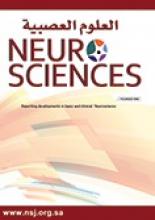Article Figures & Data
Tables
Migraine without aura Migraine with typical aura A.5 attacks or more
B.Headache attacks lasting 4-72 hours
C.Headache characteristics (2 of the following):
1. Unilateral location
2. Pulsating quality
3. Moderate or severe pain intensity
4. Aggravated by or causing avoidance of routine physical activity
D. Associated symptoms:
1. Nausea and/or vomiting
2. Photophobia and phonophobiaA.2 attacks or more
B. Aura (no motor weakness):
1. Fully reversible visual symptoms
2. Fully reversible sensory symptoms
3. Fully reversible dysphasic speech disturbance
C. At least 2 of the following:
-homonymous visual symptoms
-unilateral sensory symptoms
-aura symptom develops gradually over ≥ 5 minutes
D. Headache (migraine without aura) begins during the aura or follows aura within 60 minutesFirst line medications Triptans Second line medications Ergot derivatives Specific Rx Dose Side effects Drug Dose Side effects Almotriptan 12.5 mg, max 25 mg/day Dizziness, weakness. Hot flushes, nausea, and vomiting Ergotamine 2 mg, max 6 mg/day Nausea, vomiting, rebound headache Dihydro-ergotamine 1 mg IM or IV, max of 2 mg/day Nausea, leg cramps at site of injection Eletriptan 40 mg, max 5 mg/day Frovatriptan 2.5 mg, max 5 mg/day Naratriptan 2.5 mg, max 5 mg/day Pins and needles sensation, elevated blood pressure Rizatriptan 5 or 10 mg, max 20 mg/day Sumatriptan 50 mg, max 200-300 mg/day Zolmitriptan 2.5 mg, max10 mg/day NSAID Other classes Non-specific Rx Dose Side effects Dose Side effects Diclofenac 50 mg, max 150 mg/day GI upset Butalbital Max 4 tablets/day Weakness, addictive potential Ibuprofen 400 mg, max 2400 mg/day Opioids Limits for each individual drug Addiction or drug dependency Steroids Limits for each individual drug Usual steroid adverse effects Rx -prescription, max - maximum, IM - intramuscular, IV - intravenous, GI - gastrointestinal
- Table 3
Level of recommendation and evidence for prophylactic medication used for migraine according to the U.S.,13,19,25 Canadian,15 French4 and EFNS25 guidelines.
Drug 2012 U.S. guidelines Canadian guidelines French guidelines EFNS Valproate* Level A Weak recommendation, HQE DE, Grade A methodology Level A Topiramate* Level A Strong recommendation, HQE DE, Grade A methodology Level A Carbamazepine* Level C Not rated Not rated Not rated Gabapentin* Level U Strong recommendation, MQE Doubtful efficacy, Grade B or C methodology Level C Lamotrigine* Ineffective Not rated Not rated Not rated Amitriptyline† Level B Strong recommendation, HQE PE, Grade B or C methodology Level B Venlafaxine† Level B weak recommendation, LQE PE, Grade B or C methodology Level B Fluoxetine† Level U Not rated Not rated Not rated Pizotifen† Not rated Weak recommendation, HQE PE, Grade B or C methodology Not rated Metoprolol† Level A Strong recommendation, HQE DE, Grade A methodology Level A Propranolol† Level A Strong recommendation, HQE Not rated Level A Timolol‡ Level A Not rated PE, Grade B or C methodology Not rated Atenolol‡ Level B Not rated PE, Grade B or C methodology Not rated Nadolol‡ Level B Strong recommendation, MQE PE, Grade B or C methodology Not rated Nebivolol‡ Level C Not rated Probable efficacy, Grade B or C methodology Not rated Acebutolol‡ Ineffective Not rated Not rated Not rated Verapamil¦ Level U Weak recommendation, LQE Not rated Not rated Candesartan¦ Level C Strong recommendation, MQE PE, Grade B or C methodology Level C Lisinopril¦ Level C Weak recommendation, LQE Not rated Level C Naproxen¦ Level B Not rated PE, Grade B or C methodology Level B Aspirin** Level U Not rated Not rated Level C Feverfew** Level B Not recommended Not rated Not rated Petasites** Level A Not rated Not rated Level B Butterbur** Not rated Strong recommendation, MQE Not rated Not rated Coenzyme 10** Level C Strong recommendation, LQE Not rated Level C Riboflavin** Level B Strong recommendation, LQE Not rated Level C Magnesium** Level B Strong recommendation, LQE Not rated Level C HQE - high quality evidence, LQE - low quality evidence, MQE - moderate quality evidence, DE - demonstrated efficacy, PE - probable efficacy, EFNS - European Federation of Neurological Societies, U.S. - United States of America, symbols represent different groups of medications






